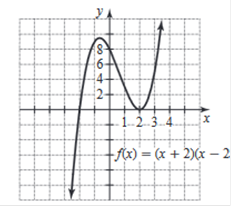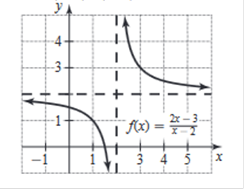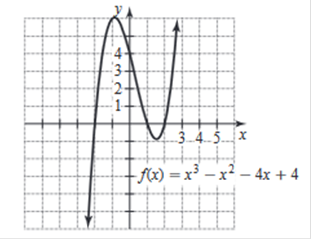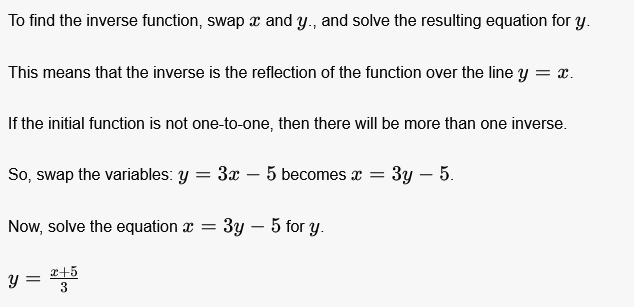|
Accounting | Business | Computer Science | General Studies | Math | Sciences | Civics Exam | Help/Support | Join/Cancel | Contact Us | Login/Log Out Intermediate
Algebra Chapter 1 2 3 4 5 6 7 8 9 10 11
Elementary and Intermediate Algebra Chapter 11: Functions
These Study Guides Are 100% Free
 Donate Please (Help keep it free)! This course is 100% Free. If you need more help with your class, I suggest Joining Now! Determine
whether {(0, 5), (9, 5), (4, 5)} is a function.
Yes The domain is the set of all
"x" values Domian for this set: 0, 9, 4
If each x-value corresponds with
only one y-value, then the relation is a function. 11 Simply plug in the value (-3)
Set the radicand in √x−7 greater
than or equal to 0 to find where the expression is defined.
No explanation needed. If a ball is tossed into
the air from height of 6 feet with a velocity of 32 feet per second,
Sketch the graph pf the function or
relation and state the domain range. f(x) =
(-∞, ∞), (-∞, ∞)
Now we use the slope-intercept
form to find the slope and y-intercept. y = mx + b
m =
Rewrite in slope-intercept form. y = −
Use the slope-intercept form to find the slope and y-intercept. Find the values of m and b using the form y = mx + b m = − The slope of the line is the value of m, and the y-intercept is the value of b. Slope: − Any line can be graphed using two points. Select two x values, and plug them into the equation to find the corresponding y values. x: 0 | 3 y: 1
| -1 Graph the function. Identify all
intercepts. f(x) = (x + 2) (x – 2)2
Find the point at x = −1 Graph the function. Identify all
intercepts. f(x) =
Consider the rational function 1. If n < m, then the x-axis, y =
0, is the horizontal asymptote. Find n and m. n = 1 m
= 1 There is no oblique asymptote
because the degree of the numerator is less than, No Oblique Asymptotes Graph the function. Identify all
intercepts. f(x) = x3 – x2 - 4x + 4 x-intercepts (-2, 0), (1, 0), (2, 0)
Find the x-intercepts. To find the x-intercept(s), substitute in 0 for y and solve
for x. Solve the equation - Rewrite the equation as x3 −x2
− 4x + 4 = 0. Factor the left side of the
equation. Factor out the greatest common factor from each group. Factor the polynomial by factoring
out the greatest common factor, x−1. Factor. Since both terms are perfect
squares, factor using the difference of squares formula, Remove unnecessary parentheses. (x − 1)(x + 2)(x − 2)
= 0 x = 1, −2, 2 Find the y-intercepts. To find the y-intercept(s),
substitute in 0 for x and solve for y. Solve the equation. Remove parentheses. Remove parentheses. y = (0)3 − (0)2 −4 · 0 + 4 y-intercept(s) in point form. y-intercept(s): (0,4) y-intercept(s): (0,4) Solve the inequality. State
the solution set using interval notation. x3 + 4x2 – 32x
> 0 (-8, 0) ∪ (4, ∞) Convert the
inequality to an equation. Factor the left
side of the equation. x(x−4) (x+8) = 0 the entire
expression will be equal to 0. Set x equal to 0. x = 0 The final solution
is all the values that make x(x−4) (x+8) = 0 true. Use each root to
create test intervals. Choose a test value
from each interval and plug this value into the original inequality x < −8 False The solution
consists of all of the true intervals. Solve the inequality. State
the solution set using interval notation. (∞, -5) ∪ (0, 5)
x < −5 −5
< x < 0 0 < x <
5 x > 5 x < −5 True −5 < x < 0 False 0 < x <5 True x > 5 False The solution consists of all of
the true intervals. x < −5 or 0 ≤ x <5 The result can be shown in multiple forms. Let f(x)
= -2x + 5 and g(x) = x2 + 4. Find f(-3) 11 Since we are looking for f, and there is
no value for g(x), we simply Plug in the value of -3 -2(-3) + 5. -2 · -3 = 6 6 + 5 = 11 Let f(x)
= x – 7 and g(x) = x2 Write the following function as
a composition of function, H = f ∘ g Let f(x)
= x – 7 and g(x) = x2 - Write the following
function as a composition of function, W = g ∘ f Determine whether
the function is invertible. If it is invertible, find the inverse. Not Invertible Determine whether
the function is invertible. If it is invertible, find the inverse. {(3, 2), (4, 3), (5,
4)} Simply swap the numbers, in order. Find the inverse of the function: f(x) = x – 5 f-1 (x) = x
+ 5 To find the inverse function, swap x and y., and solve the
resulting equation for y. y = x + 5
Find the inverse of
the function: f(x) = 3x – 5
f-1 (x) =
Find the inverse of
the function: f(x) = f-1 (x) = x3
– 9 Move the index (3) to the square 3 over x,
and multiply 9 by -1 x1(3) + 9(-1) = x3 +
9 Find the inverse of
the function: f(x) = f-1 (x) = 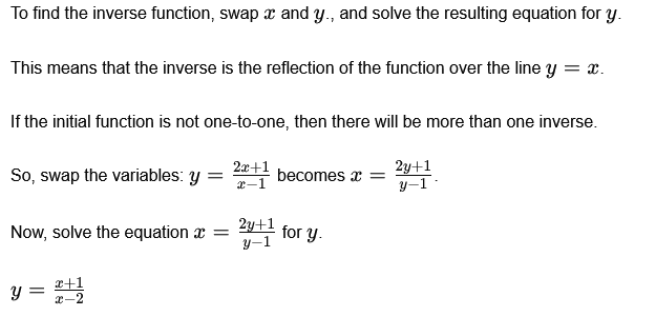 |
| Home |
Accounting & Finance | Business |
Computer Science | General Studies | Math | Sciences |
Civics Exam |
Everything
Else |
Help & Support |
Join/Cancel |
Contact Us |
Login / Log Out |

